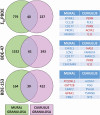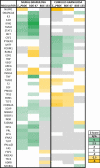Polybrominated Diphenyl Ethers in Human Follicular Fluid Dysregulate Mural and Cumulus Granulosa Cell Gene Expression
- PMID: 33543239
- PMCID: PMC7853176
- DOI: 10.1210/endocr/bqab003
Polybrominated Diphenyl Ethers in Human Follicular Fluid Dysregulate Mural and Cumulus Granulosa Cell Gene Expression
Abstract
Polybrominated diphenyl ethers (PBDEs), a major class of flame retardants incorporated into numerous consumer products, leach out into dust resulting in widespread exposure. There is evidence from in vitro and in vivo animal studies that PBDEs affect ovarian granulosa cell function and follicular development, yet human studies of their association with female infertility are inconclusive. Here, we tested the hypothesis that exposure to the PBDEs in follicular fluid is associated with dysregulation of gene expression in the mural and cumulus granulosa cells collected from women undergoing in vitro fertilization by intracytoplasmic sperm injection. The median concentration of the ∑ 10PBDEs detected in the follicular fluid samples (n = 37) was 15.04 pg/g wet weight. RNA microarray analyses revealed that many genes were differentially expressed in mural and cumulus granulosa cells. Highest vs lowest quartile exposure to the Σ 10PBDEs or to 2 predominant PBDE congeners, BDE-47 or BDE-153, was associated with significant effects on gene expression in both cell types. Mural granulosa cells were generally more sensitive to PBDE exposure compared to cumulus cells. Overall, gene expression changes associated with BDE-47 exposure were similar to those for ∑ 10PBDEs but distinct from those associated with BDE-153 exposure. Interestingly, exposure to BDE-47 and ∑ 10PBDEs activated the expression of genes in pathways that are important in innate immunity and inflammation. To the best of our knowledge, this is the first demonstration that exposure to these environmental chemicals is associated with the dysregulation of pathways that play an essential role in ovulation.
Keywords: gene expression; granulosa cell; ovary; polybrominated diphenyl ethers.
© The Author(s) 2021. Published by Oxford University Press on behalf of the Endocrine Society. All rights reserved. For permissions, please e-mail: journals.permissions@oup.com.
Figures






References
-
- Wu Z, He C, Han W, et al. Exposure pathways, levels and toxicity of polybrominated diphenyl ethers in humans: a review. Environ Res. 2020;187:109531. - PubMed
-
- Besis A, Samara C. Polybrominated diphenyl ethers (PBDEs) in the indoor and outdoor environments—a review on occurrence and human exposure. Environ Pollut. 2012;169:217-229. - PubMed
-
- Hites RA. Polybrominated diphenyl ethers in the environment and in people: a meta-analysis of concentrations. Environ Sci Technol. 2004;38(4):945-956. - PubMed
Publication types
MeSH terms
Substances
Grants and funding
LinkOut - more resources
Full Text Sources
Other Literature Sources
Molecular Biology Databases

